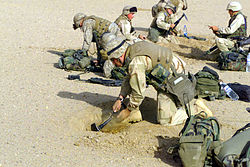- Defensive fighting position
-
"Foxholes" redirects here. For the North Yorkshire village, see Foxholes, North Yorkshire.
A defensive fighting position (DFP) is a type of earthwork constructed in a military context, generally large enough to accommodate at least one person.
Contents
Terminology
A DFP is known more commonly within United States Army slang as a "foxhole", or the slang term "ranger grave", within United States Marine Corps slang as a "fighting hole", in Australian and New Zealand Army Corps (ANZAC) forces terminology as a "fighting pit", in Australian Army terminology as a "Gun-Pit", within the British and Canadian military argot as a "slit trench", or simply—but less accurately—as a "trench".
History
Early in World War II, during the fighting in North Africa, U.S. forces employed the slit trench. This was a very shallow excavation allowing one man to lie horizontally while shielding his body from nearby shell bursts and small arms fire.[1][2] The slit trench soon proved inadequate in this role, as the few inches of dirt above the soldier's body could often be penetrated by bullets or shell fragments. It also exposed the user to assault by enemy tanks, which could crush the man inside a shallow slit trench by driving into it, then making a simple half-turn.[3]
After the Battle of Kasserine Pass, U.S. troops increasingly adopted the modern foxhole, a vertical, bottle-shaped hole that allowed a soldier to stand and fight with head and shoulders exposed.[2][4] The foxhole widened near the bottom to allow a soldier to crouch down while under intense artillery fire or tank attack.[2] Foxholes could be enlarged to two-man fighting positions, as well as excavated with firing steps for crew-served weapons or sumps for water drainage or grenade disposal.
Tobruk
Hardened fortifications known as "Tobruks" were used by the Germans in North Africa and later in the Atlantic Wall fortifications. They were in essence a foxhole made from concrete. They were officially known as Ringstände by the Germans, and "Tobruks" by the Allies, as they had first been encountered there during the fighting in Africa.[5]
Modern defensive fighting positions
Modern militaries publish and distribute elaborate field manuals for the proper construction of DFPs in stages. Each stage develops the fighting position, gradually increasing its effectiveness, while always maintaining functionality. In this way a soldier can improve the position over time, while being able to stop at any time and use the position in a fight.
Typically, a DFP is a pit dug deep enough to stand in, with only the head exposed, and a small step at the bottom that allows the soldier to sit down in the hole to avoid fire and tank treads. Also, there are usually deeper, narrow slits called grenade sumps at the bottom to allow a grenade to be kicked in to minimize damage.
Time permitting, DFPs can be enlarged to allow a machine gun crew and ammunition to be protected, as well as additional overhead cover via timbers.
See also
Notes
- ^ Brown, Albert S. "Anzio: Jan-May 1944". World War II Memories of Staff Sergeant Albert S. Brown. Dogface Soldiers Memoirs. http://www.dogfacesoldiers.org/info/memoirs/brown/anzio.htm.
- ^ a b c Westrate, Edwin V. (1944). Forward Observer. New York City: Stratford Press. pp. 46–47.
- ^ Westrate, Edwin V. (1944). Forward Observer. New York City: Stratford Press. p. 115.
- ^ Westrate, Edwin V. (1944). Forward Observer. New York City: Stratford Press. p. 77.
- ^ Zaloga, Steven J. D-Day Fortifications in Normandy (Osprey Publishing Ltd.) ISBN 1-84176-876-6 p.21
References
- Westrate, Edwin V. (1944). Forward Observer. New York City: Stratford Press.
External links
Categories:
Wikimedia Foundation. 2010.



